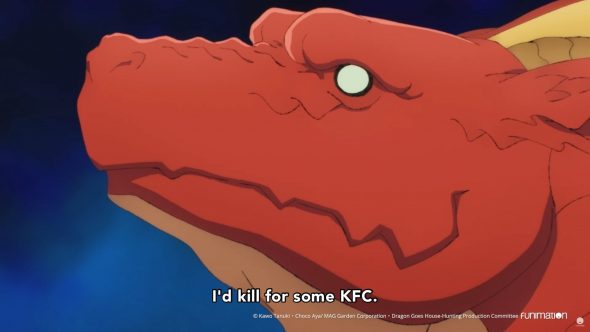“Karaage” is NOT “KFC”
As long time readers of my blog will know, I’ve LONG been an advocate of “accurate but readable” subtitles in anime, and adaptations in manga. I don’t like “localization” because adaptations made with this mindset make rewrites that change the tone or are just plain wrong.
That said, I was made aware of a tweet from Giuseppe Nelva, who postulated a question concerning FUNimation’s subtitles for Dragon Goes House-Hunting. This resulted in some discussions on the topic. Naturally, once sucked in, I had to respond. 😜
Karaage Tabetai
I don’t know anything about Dragon Goes House-Hunting, but apparently, there’s a moment when the red dragon says, “Karaage tabetai.” The literal translation would be “I’d like to eat some karaage”, since karaage is something you can order in some Japanese restaurants. However, official adaptations usually translate “karaage” as “fried chicken”. That’s because karaage is a fried cooking style, primarily used for boneless, dark meat chicken pieces.
FUNimation’s official translation for the term was as follows.
This lead Giuseppe to make the following tweet.
How the heck did “Karaage tabetai” become “I’d kill for some KFC?”
Aside from the change in tone, are these people aware that Karaage is food that exists and doesn’t need to be changed into something that has nothing to do with it but just happens to be American? 🤔
Why indeed?
Karaage ≠ KFC
It may come as quite a shock to some folks, but if you were in Japan and attempted to order karaage at a KFC there, you wouldn’t get karaage. They wouldn’t know what you actually wanted as they have “original chicken” (yes, they use the English term), popcorn chicken (again, using the English term), “colonel crispy” (their English term for extra crispy chicken fingers), nuggets, and “hone nashi Kentucky” (normal. boneless chicken tender). Karaage isn’t on the menu because it is a Japanese style of frying foods, not an American one (or pseudo American one).
There are three different ways to fry chicken in Japan. Karaage is one way, and usually done with boneless dark meat. Tempura is another, usually done with boneless chicken tenders. And finally there’s katsu, in which a boneless chicken breast is used. (Tonkatsu is when a pork cutlet is fried katsu-style, and it one of my favorite Japanese dishes.) They are vastly different. But since karaage is mostly used to fry dark meat chicken, it gets considered as “Japanese fried chicken”.
Nevertheless, the chicken one gets at KFC and karaage fried chicken are two completely different things. Just because both use chicken, breading, and have the chicken fried in oil doesn’t make them interchangeable. But this kind of mindset is why “tidal wave” is still incorrectly used for “tsunami”. Both things are set in the ocean and deal with waves/rising seas. But they are completely different things.
Trivial Concerns?
In the grand scheme of this, is the incorrect usage of “KFC” as a term for “karaage” (just because some localizer wanted to put their stamp on the actual script to be “cool” or something) a trivial concern? Sure. But at the same time, I’ve learned that if you don’t object to little trivial concerns, eventually they become much bigger and thus much more annoying to deal with.
It would have been so easy to keep the translation accurate but readable. KFC is a trademarked thing. Yum! Brands, the owners of KFC, may not care that their trademarked name is being used without authorization in a commercial product. But they could object, but that’s highly unlikely unless the folks at KFC end up not wanting to be associated with FUNimation, Sony, or Dragon Goes House-Hunting.
Clearly, the adapter likes KFC. But what about Popeyes? Or Church’s? What about Bojangles? Or Raising Cane’s? Further, you have a dragon in another world craving Kentucky Fried Chicken for some reason. How does that make sense?
“Well, karaage is Japanese fried chicken, so how does that make sense?”
Clearly in this context, karaage is being used as a generalized term for “fried chicken”. But this other world COULD have actual karaage fried chicken, much the same way they have swords, shields, bows, etc. However, they would NOT have a KFC.
Bottom Line
In the end, FUNimation’s incorrect subtitle is not the end of the world. Nevertheless, this is a case where some localizer feels the need to remake something into something “better” (which is always subjective, and disrespectful the the original authors), when keeping things accurate but readable would have been the better option.
Leave any thoughts you have on the subject in the comments below.



 August 1st, 2021
August 1st, 2021  AstroNerdBoy
AstroNerdBoy 

 Posted in
Posted in  Tags:
Tags: 
That, and I just love (/s) the exaggeration frequently done in “localizing” language. Such as “I’d kill for”.
Yes, I get that Japanese is often much more subtle and that something that can be literally translated as “you” may show deep contempt. But don’t insert American-style exaggerated sentiment where none exists, and completely change the tone.
Maybe it’s helpful to people who only want to watch American fare (???), but it’s really jarring to someone who wants to watch Japanese fare.
Like hearing someone’s grandmother say “Oh, bless your heart. It’s not fair to expect you to understand such complicated matters, is it?”…
and seeing the subtitle claim she literally said “Haha, you’re too f***ing stupid to breathe, get outta my face with that s*** you punka** m*****f*****!”
(Yes, that’s an accurate approximation of how a teenager might express the same sentiment. But we’re not watching a teenager say it, we’re watching a grandmother say it.)
Exactly!
Thanks for the thoughts!